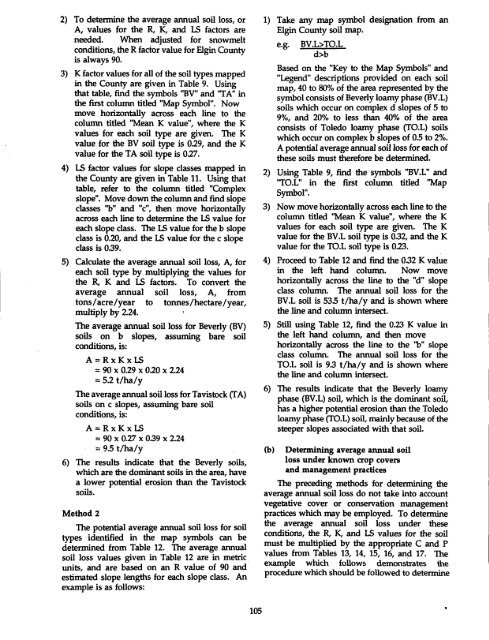The Soils of Elgin County - Agriculture and Agri-Food Canada
The Soils of Elgin County - Agriculture and Agri-Food Canada
The Soils of Elgin County - Agriculture and Agri-Food Canada
- No tags were found...
You also want an ePaper? Increase the reach of your titles
YUMPU automatically turns print PDFs into web optimized ePapers that Google loves.
2) To determine the average annual soil loss, orA, values for the R, K, <strong>and</strong> LS factors areneeded. When adjusted for snowmeltconditions, the R factor value for <strong>Elgin</strong> <strong>County</strong>is always 90 .3) K factor values for all <strong>of</strong> the soil types mappedin the <strong>County</strong> are given in Table 9 . Usingthat table, find the symbols 'BV" <strong>and</strong> 'TA" inthe first column tided "Map Symbol" . Nowmove horizontally across each line to thecolumn tided 'Mean K value", where the Kvalues for each soil type are given. <strong>The</strong> Kvalue for the BV soil type is 0.29, <strong>and</strong> the Kvalue for the TA soil type is 0.27.4) IS factor values for slope classes mapped inthe <strong>County</strong> are given in Table 11 . Using thattable, refer to the column titled "Complexslope" . Move down the column <strong>and</strong> find slopeclasses "b" <strong>and</strong> "c", then move horizontallyacross each line to determine the IS value foreach slope class . <strong>The</strong> LS value for the b slopeclass is 0.20, <strong>and</strong> the LS value for the c slopeclass is 0.39 .5) Calculate the average annual soil loss, A, foreach soil type by multiplying the values forthe R, K <strong>and</strong> LS factors. To convert theaverage annual soil loss, A, fromtons/acre/year to tonnes/hectare/year,multiply by 2.24 .<strong>The</strong> average annual soil loss for Beverly (BV)soils on b slopes, assuming bare soilconditions, is :A=RxKXLS=90 x0.29 x0.20 x2.24= 5.2 t/ha/y<strong>The</strong> average annual soil loss for Tavistock (TA)soils on c slopes, assuming bare soilconditions, is :A=RxKxLS=90 x0.27 x0.39 x2.24= 9.5 t/ha/y6) <strong>The</strong> results indicate that the Beverly soils,which are the dominant soils in the area, havea lower potential erosion than the Tavistocksoils .Method 2<strong>The</strong> potential average annual soil loss for soiltypes identified in the map symbols can bedetermined from Table 12 . . <strong>The</strong> average annualsoil loss values given in Table 12 are in metricunits, <strong>and</strong> are based on an R value <strong>of</strong> 90 <strong>and</strong>estimated slope lengths for each slope class. Anexample is as follows:1) Take any map symbol designation from an<strong>Elgin</strong> <strong>County</strong> soil map.e.g .BV.L>TO.Ld>bBased on the "Key to the Map Symbols" <strong>and</strong>"Legend" descriptions provided on each soilmap, 40 to 80% <strong>of</strong> the area represented by thesymbol consists <strong>of</strong> Beverly loamy phase (BV.L)soils which occur on complex d slopes <strong>of</strong> 5 to9%, <strong>and</strong> 20% to less than 40% <strong>of</strong> the areaconsists <strong>of</strong> Toledo loamy phase (TO.L) soilswhich occur on complex b slopes <strong>of</strong> 0.5 to 2%.A potential average annual soil loss for each <strong>of</strong>these soils must therefore be determined.2) Using Table 9, find the symbols 'BV.L" <strong>and</strong>'TO1" in the first column titled 'MapSymbol".3) Nowmove horizontally across each line to thecolumn titled 'Mean K value", where the Kvalues for each soil type are given. <strong>The</strong> Kvalue for the BV .L soil type is 0.32, <strong>and</strong> the Kvalue for the TO.L soil type is 0.23.4) Proceed to Table 12 <strong>and</strong> find the 0.32 K valuein the left h<strong>and</strong> column. Now movehorizontally across the line to the "d" slopeclass column. <strong>The</strong> annual soil loss for theBV .L soil is 53 .5 t/ha/y <strong>and</strong> is shown wherethe line <strong>and</strong> column intersect.5) Still using Table 12, find the 0.23 K value inthe left h<strong>and</strong> column, <strong>and</strong> then movehorizontally across the line to the "b" slopeclass column. <strong>The</strong> annual soil loss for theTO .L soil is 9.3 t/ha/y <strong>and</strong> is shown wherethe line <strong>and</strong> column intersect .6) <strong>The</strong> results indicate that the Beverly loamyphase (BVI) soil, which is the dominant soil,has a higher potential erosion than the Toledoloamy phase (TO.L) soil, mainly because <strong>of</strong> thesteeper slopes associated with that soil.(b)Determining average annual soilloss under known crop covers<strong>and</strong> management practices<strong>The</strong> preceding methods for determining theaverage annual soil loss do not take into accountvegetative cover or conservation managementpractices which maybe employed. To determinethe average annual soil loss under theseconditions, the R, K, <strong>and</strong> LS values for the soilmust be multiplied by the appropriate C <strong>and</strong> Pvalues from Tables 13, 14, 15, 16, <strong>and</strong> 17. <strong>The</strong>example which follows demonstrates theprocedure which should be followed to determine105
















